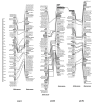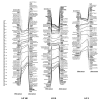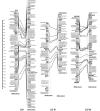Enhancing genetic mapping of complex genomes through the design of highly-multiplexed SNP arrays: application to the large and unsequenced genomes of white spruce and black spruce
- PMID: 18205909
- PMCID: PMC2246113
- DOI: 10.1186/1471-2164-9-21
Enhancing genetic mapping of complex genomes through the design of highly-multiplexed SNP arrays: application to the large and unsequenced genomes of white spruce and black spruce
Abstract
Background: To explore the potential value of high-throughput genotyping assays in the analysis of large and complex genomes, we designed two highly multiplexed Illumina bead arrays using the GoldenGate SNP assay for gene mapping in white spruce (Picea glauca [Moench] Voss) and black spruce (Picea mariana [Mill.] B.S.P.).
Results: Each array included 768 SNPs, identified by resequencing genomic DNA from parents of each mapping population. For white spruce and black spruce, respectively, 69.2% and 77.1% of genotyped SNPs had valid GoldenGate assay scores and segregated in the mapping populations. For each of these successful SNPs, on average, valid genotyping scores were obtained for over 99% of progeny. SNP data were integrated to pre-existing ALFP, ESTP, and SSR markers to construct two individual linkage maps and a composite map for white spruce and black spruce genomes. The white spruce composite map contained 821 markers including 348 gene loci. Also, 835 markers including 328 gene loci were positioned on the black spruce composite map. In total, 215 anchor markers (mostly gene markers) were shared between the two species. Considering lineage divergence at least 10 Myr ago between the two spruces, interspecific comparison of homoeologous linkage groups revealed remarkable synteny and marker colinearity.
Conclusion: The design of customized highly multiplexed Illumina SNP arrays appears as an efficient procedure to enhance the mapping of expressed genes and make linkage maps more informative and powerful in such species with poorly known genomes. This genotyping approach will open new avenues for co-localizing candidate genes and QTLs, partial genome sequencing, and comparative mapping across conifers.
Figures




Similar articles
-
Near-saturated and complete genetic linkage map of black spruce (Picea mariana).BMC Genomics. 2010 Sep 24;11:515. doi: 10.1186/1471-2164-11-515. BMC Genomics. 2010. PMID: 20868486 Free PMC article.
-
A high-resolution reference genetic map positioning 8.8 K genes for the conifer white spruce: structural genomics implications and correspondence with physical distance.Plant J. 2017 Apr;90(1):189-203. doi: 10.1111/tpj.13478. Epub 2017 Mar 6. Plant J. 2017. PMID: 28090692
-
Development of high-density SNP genotyping arrays for white spruce (Picea glauca) and transferability to subtropical and nordic congeners.Mol Ecol Resour. 2013 Mar;13(2):324-36. doi: 10.1111/1755-0998.12062. Epub 2013 Jan 25. Mol Ecol Resour. 2013. PMID: 23351128
-
Large SNP arrays for genotyping in crop plants.J Biosci. 2012 Nov;37(5):821-8. doi: 10.1007/s12038-012-9225-3. J Biosci. 2012. PMID: 23107918 Review.
-
Is It Ordered Correctly? Validating Genome Assemblies by Optical Mapping.Plant Cell. 2018 Jan;30(1):7-14. doi: 10.1105/tpc.17.00514. Epub 2017 Dec 20. Plant Cell. 2018. PMID: 29263086 Free PMC article. Review.
Cited by
-
A SNP resource for Douglas-fir: de novo transcriptome assembly and SNP detection and validation.BMC Genomics. 2013 Feb 28;14:137. doi: 10.1186/1471-2164-14-137. BMC Genomics. 2013. PMID: 23445355 Free PMC article.
-
Near-saturated and complete genetic linkage map of black spruce (Picea mariana).BMC Genomics. 2010 Sep 24;11:515. doi: 10.1186/1471-2164-11-515. BMC Genomics. 2010. PMID: 20868486 Free PMC article.
-
Molecular evolution of regulatory genes in spruces from different species and continents: heterogeneous patterns of linkage disequilibrium and selection but correlated recent demographic changes.J Mol Evol. 2010 Apr;70(4):371-86. doi: 10.1007/s00239-010-9335-1. Epub 2010 Mar 31. J Mol Evol. 2010. PMID: 20354847 Free PMC article.
-
High-throughput SNP genotyping in Cucurbita pepo for map construction and quantitative trait loci mapping.BMC Genomics. 2012 Feb 22;13:80. doi: 10.1186/1471-2164-13-80. BMC Genomics. 2012. PMID: 22356647 Free PMC article.
-
Open access to tree genomes: the path to a better forest.Genome Biol. 2013 Jun 24;14(6):120. doi: 10.1186/gb-2013-14-6-120. Genome Biol. 2013. PMID: 23796049 Free PMC article.
References
-
- Moran JL, Bolton AD, Tran PV, Brown A, Dwyer ND, Manning DK, Bjork BC, Li C, Montgomery K, Siepka SM, Vitaterna MH, Takahashi JS, Wiltshire T, Kwiatkowski DJ, Kucherlapati R, Beier DR. Utilization of a whole genome SNP panel for efficient genetic mapping in the mouse. Genome Res. 2006;16:436–440. doi: 10.1101/gr.4563306. - DOI - PMC - PubMed
Publication types
MeSH terms
Substances
LinkOut - more resources
Full Text Sources

